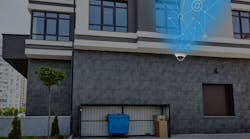The burgeoning thirst for information at the enterprise level is driving cloud adoption in almost every technology sector. However, when it comes to the physical security marketplace, the explosive growth of IP-based video surveillance dictates a cloud solution to handle massive amounts of streaming data, ever-increasing video resolution and the bottomless pit that is data storage.
The undeniable benefits of IP-based video surveillance in public safety, enterprise-sized companies, critical infrastructure and campus environments to monitor, detect and deter potential threats requires massive amounts of data generated and stored across an organization’s network. The technology researchers at IHS Technologies said that an average of 566 petabytes of data was generated in a single day just three years ago (2015) from new camera installations worldwide. IHS Technologies expects that figure to increase to more than 2,500 petabytes daily beginning in 2019.
So the challenges of increased usage of streaming video surveillance and the pressure brought by extended video retention have end users and integrators alike scrambling to find cost-effective and secure ways to aggregate, process and analyze this explosion of data.
Cloud Acceptance Brings Enhanced Applications
For technologists like Andreas Pettersson, the CEO of Arcules, an independent spin-off from Milestone Systems parent-company Canon that debuted this past spring at the ISC West event in Las Vegas, if you take the approach of a Super Hero who values big ideas and embraces challenges, creating a smarter and safer world is easy.
Pettersson told SecurityInfoWatch.com editor Joel Griffin earlier this year that when Arcus was initially developed, there was a trend in the industry at the time of pushing more and more functionality to the edge. And now that IoT solutions and the increasing adoption of cloud technology are widely accepted, new opportunities have opened for the security industry to transform this convergence into a unified platform for intelligent video surveillance, collection and analytics.
As Pettersson sees it, as enterprise organizations look to coordinate both security and non-security IoT devices into their cloud initiatives, there are steps that can be taken that can make it happen in a practical, cost-effective and secure manner.
“The cloud is a secure platform where artificial intelligence (AI) can be applied to data collected from both security and non-security IoT devices. This allows users to view all data in a central location and extract business insights on demand from that previously untapped information. With a centralized platform in the cloud, users can manage and monitor entire surveillance solutions from anywhere,” Pettersson explains. “Securing data transmissions even further, the Arcules solution uses encryption at rest in its cloud platform. As a member of the EU Cloud Code of Conduct, Arcules also proactively monitors for digital security vulnerabilities and keeps track of privacy logs in the event an audit is required.”
Pettersson says that advanced AI solutions are transforming the ubiquitous video surveillance camera into a robust intelligence-gathering sensor capable of invaluable analytics and actionable intelligence that can drive better business decisions, optimize operations and improve security.
“With a solution that combines and analyzes video and sensor data from a variety of sources, machine learning and AI can help these solutions train and improve over time, identifying more specialized solutions for the user. With intelligent video, for example, organizations can improve their physical security measures and move safety protocols from reactive to proactive to preventative. In a hotel setting, for instance, intelligent video allows for footpath analysis which can help hotels monitor traffic flow. If hotels understand how guests are moving inside the building, they can both improve the guest experience by adjusting staffing and layout but also identify vulnerabilities in how they secure their property and when they may need more physical security team members on duty,” says Pettersson.
As Pettersson and his team of Super Heroes look into the future, he admits that even more proactive solutions can be attained. “The adoption of AI and the cloud can further advance the development of predictive modeling solutions. When organizations have the ability to predict an event, it ensures they are able to take robust action before incidents, like a robbery, occur.”
How to Leverage Cloud Video
This proactive situational awareness derived from myriad data sources figures to drive risk oversight along the enterprise video platforms providing context to events. That is a benefit Pettersson believes makes cloud applications a must.
“Leveraging cloud technologies and advanced analytics, a connected platform transforms enterprise video and IoT sensor data into usable insights that can help organizations reduce operational costs and increase business efficiencies. With video, organizations gain visual context for the data collected from IoT sensors, tying everything together and providing users deeper insights that previously go unnoticed,” Pettersson says. “In large facilities, for example, intelligent video can supplement building surveillance programs, immediately alerting physical security officers to perimeter breaches and shortening response times. Using data gathered from IoT sensors, intelligent video surveillance platforms provide organizations with an ability to make informed decisions that help mitigate risk and improve safety.”
Yet, from a security standpoint, there still seem to be some residual misgivings about having an organization’s video data, forensics and proprietary information residing off-site in a cloud environment. But Pettersson figures there are enough security safeguards available to ensure the security of an organization’s sensor device data given basic policies and procedures are developed by executive staff to create a data-secure company culture.
“Physical security companies should encrypt inbound and outbound data with organization-specific encryption keys to ensure data is not viewable by unauthorized parties. Routine auditing, monitoring and analysis of account and security controls allow security solutions to disclose abnormal patterns and identify suspicious activity before data can be compromised, “says Pettersson.
He also adds that Arcules demonstrates its security commitment even further through its EU Cloud Code of Conduct membership and its GDPR compliance. The company also trains its internal staff on how to handle sensitive and personally identifiable information. Employees are trained on a yearly and as-needed basis to ensure they understand how to correctly handle this data.
5 Things to Consider for Cloud Adaptation
Pettersson suggests that when enterprise organizations look to do their due diligence related to a cloud-based video surveillance and data solutions, there are five prime drivers that should be considered from both a technology and business-case perspective.
“For organizations interested in pursuing a cloud-based video surveillance platform, the top five things they should consider are security, data privacy, connectivity, business intelligence potential and ongoing support. Organizations will want to consider how easily a video surveillance platform integrates with existing sensors and how data is protected once it is stored in the cloud. Ideally, a video surveillance platform should offer end-to-end encryption and demonstrate its ability to remain GDPR compliant through routine audits and data processing controls. Finally, organizations should consider how a surveillance platform will transform existing video and sensor data into actionable insights, and how much additional maintenance and upkeep is required of a solution.”
About the author:
Steve Lasky is the editorial director of SecurityInfoWatch.com Security Media Group. He is a 30-plus year veteran of the security industry and a 28-year member of ASIS. He can be reached at [email protected].


